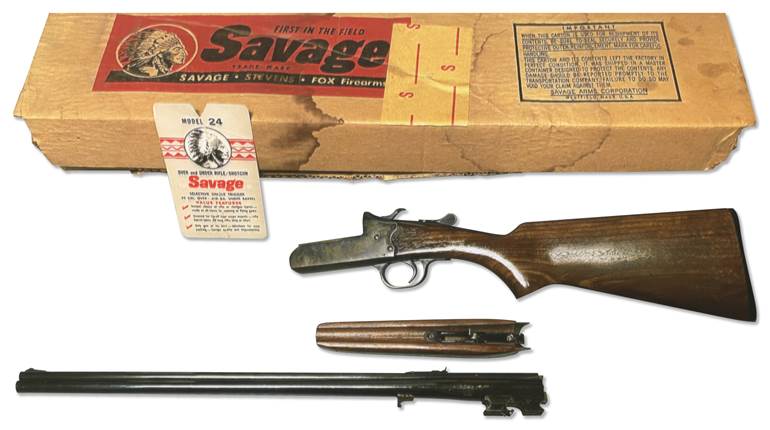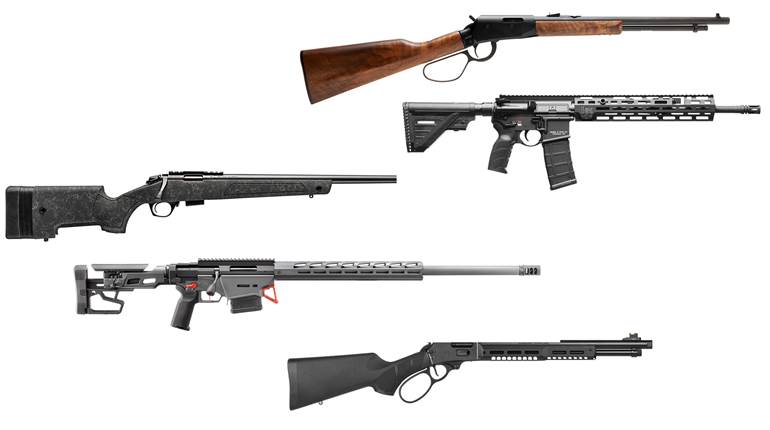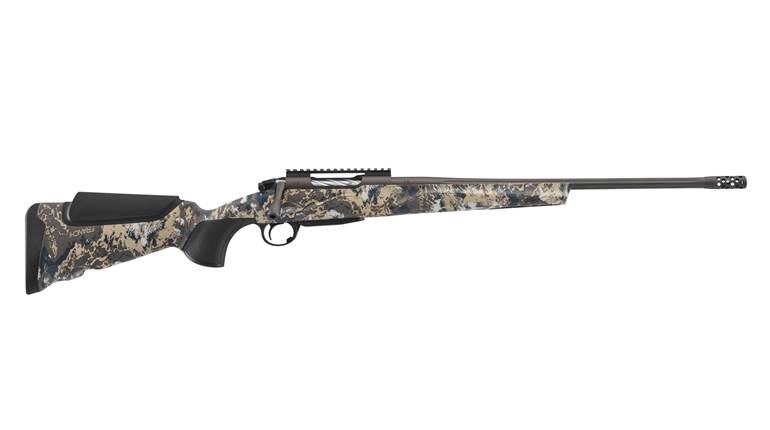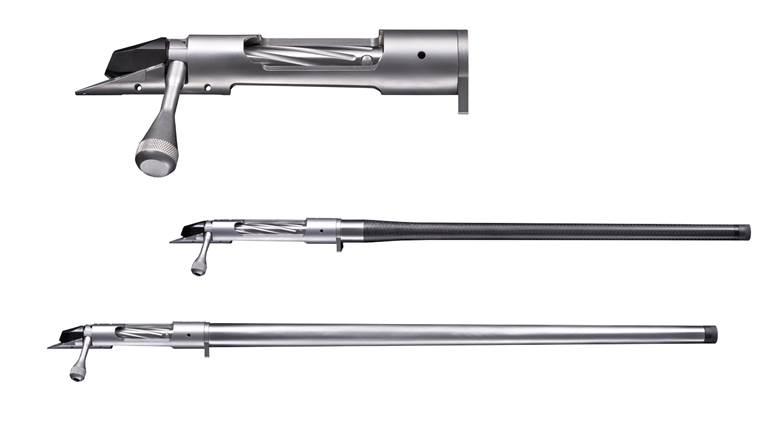
Rimfire training rifles have a proud history, predating smokeless powder in service with armies around the world. Approximating the size, conformation and handling of extant service rifles, they enabled inexpensive, fundamental instruction, both for troops and civilian shooters.
Here in the United States, their use peaked in the 1920s, with the advent of .22 Long Rifle bolt-action trainers from Springfield Armory and Savage based on the Army-issue M1903. In fact, NRA officers worked with the Department of War and firearm industry personnel to design those iconic rifles whose purpose was to foster America’s collective marksmanship skill.

Rimfire trainers—both rifles and pistols that simulate center-fire models—have been around ever since, though few were developed for actual military use. That is the case with the newly released Bergara B-14R, a faithful rimfire version of the company’s popular B-14 HMR center-fire, whose acronymic name reflects both hunting and match applications.
Moreover, Bergara contends that since the B-14 series is built on the Remington 700 footprint, this newcomer will serve as an apt trainer for any of today’s innumerable custom, semi-custom and production Model 700 derivatives. Or at least those with quasi-tactical stocks and short bull barrels.
Indeed, the rifle’s 18", No. 6-contour barrel is plenty stout, tapering from 1.25" in diameter at the recoil lug to 0.855" just behind the 1/2x28 TPI muzzle threading. More importantly, it features the same button-rifled, mirror-honed bore as supplied on Bergara center-fires, the calling card that fast-tracked the brand to prominence within accuracy circles.
Machined and assembled at the firm’s state-of-the-art plant in Spain, the B-14R matches the HMR’s vital stats at 38" in overall length and 9 lbs., 4 ozs. in weight. True to form, Bergara says the rimfire will accept Remington 700 scope-mount hardware, as well as aftermarket triggers and stocks.

Transforming the fullsize HMR receiver to cycle .22 Long Rifle involved miniaturization only to the loading and ejection ports. Both openings measure 1.36" long, though the latter is considerably wider and wraps over the top of the receiver nearly to a flat panel on the left side that bears the company name and logo.
Of course the bolt also has been modified to enable the small-bore conversion. At 5.88" overall, it is similar in length to the short-action HMR bolt, and the rear has the same sculpted shroud and protruding cocking indicator.
The actual bolt body, however, is just 2.12" long before attaching to a two-section head. In the middle is a conventional locking piece with dual opposed lugs. Up front is what Bergara calls a “floating bolt head”, a 1.82" section with squared side ribs mimicking the lugs to fit snugly into interior raceways.
But the end piece’s bottom is flattened into a five-step profile that mates with the receiver floor, and its face contains: a shallow recess for seating the .22 casehead; twin, side-mounted extractors; and an offset firing pin hole at 12 o’clock. The floating head is free to swivel, and thus remain in place when the bolt is turned into battery.
Lockup actually occurs mid-bolt, recalling Ruger’s approach to a rimfire makeover of its flagship rifle to produce the Model 77/22; the action cocks upon opening the bolt.
In today’s style, the controls include a beefy bolt handle plus a prominent bolt-release toggle, though the safety’s knurled push button on the tang’s right-hand side is only marginally larger than standard.
Like those items, the rifle comes with its big brother’s proprietary Bergara Performance Trigger, as well as a magazine dimensionally identical to an AICS-type short-action detachable box. An ambidextrous paddle release in front of the trigger guard drops the magazine. The fullsize polymer unit, however, is merely an aesthetically correct place-holder for a single-stack 10-round insert that secures the .22 Long Rifle rounds.
These modifications and shared components enable use of the HMR stock unaltered. It is molded to envelop a mini-chassis that extends from the grip to the fore-end, and mates with the receiver via pillars around the action screws and a casement around the forward recoil lug. The chassis stiffens the platform and supports the fully free-floated barrel.
In keeping with its match gun alter ego, the HMR stock offers a near-vertical pistol grip, plus a cutout on the buttstock’s lower edge to help ensure maximum contact when shooting off sandbags or to serve as a stabilizing “hook” for the shooter’s weak hand when the fore-end is rested.
Adjustments can be made to the cheekpiece, which rises up to 0.75", and to length of pull, as the rifle ships with three 0.38" removable buttpad spacers. Three sling swivel studs are installed, as well as fore-and-aft pairs of flush sling-mount cups on each side.
The cushy rubber buttpad isn’t needed for its usual job but upholds the trainer’s fidelity to the original. Stippled panels front and rear are part of the molding, and even the painted black spatter embellishment (over a graphite base coat) adds a bit of grip purchase. Fitting neatly into the stock is a robust bottom-metal unit that incorporates the trigger guard, magazine well and magazine release.
At the range, the trainer proved itself to be a highly capable stand-in. The bolt travel was smooth, and it unerringly chambered and extracted the small .22 cases.
Thanks in part to a consistent trigger pull free of creep, which broke precisely at 2 lbs., 12 ozs., accuracy was excellent, with only a couple of instances of anything that might be considered a “flier,” though granted we stuck with highly regarded Lapua Midas+, SK Long Range Match and Federal Gold Medal Target loads.
While 50 yds. is American Rifleman’s testing standard for .22 rifles, in recognition of this one’s intended purposes, we also fired benchrest groups at 100 yds.—and still averaged under minute of angle. That rivals the performance we observed when evaluating the HMR.

And that may not be the extent of the B-14R’s practical utility, because Bergara foresees more than training in its future. At the time of release, National Sales Manager Dakota Russell said, “Our customers have been requesting a gun like this for some time, and with the growing NRL22 and PRS .22 competition matches, the timing was right.”
Those matches often include targets at 200 or even 300 yds. In that vein, we’d also expect many owners to take the rifle afield, seeking to maximize effective .22 Long Rifle range on small game and varmints.
The Bergara B-14R is a proficient multi-purpose rifle that far exceeds plinker expectations, capability reflected by its $1,150 MSRP. While rimfire trainers historically carry moderate price tags, match rifles and deluxe sporters are commensurately more expensive, and a rifle versatile enough to do it all will no doubt prove to be a valuable tool for riflemen whose interests are equally diverse.







































